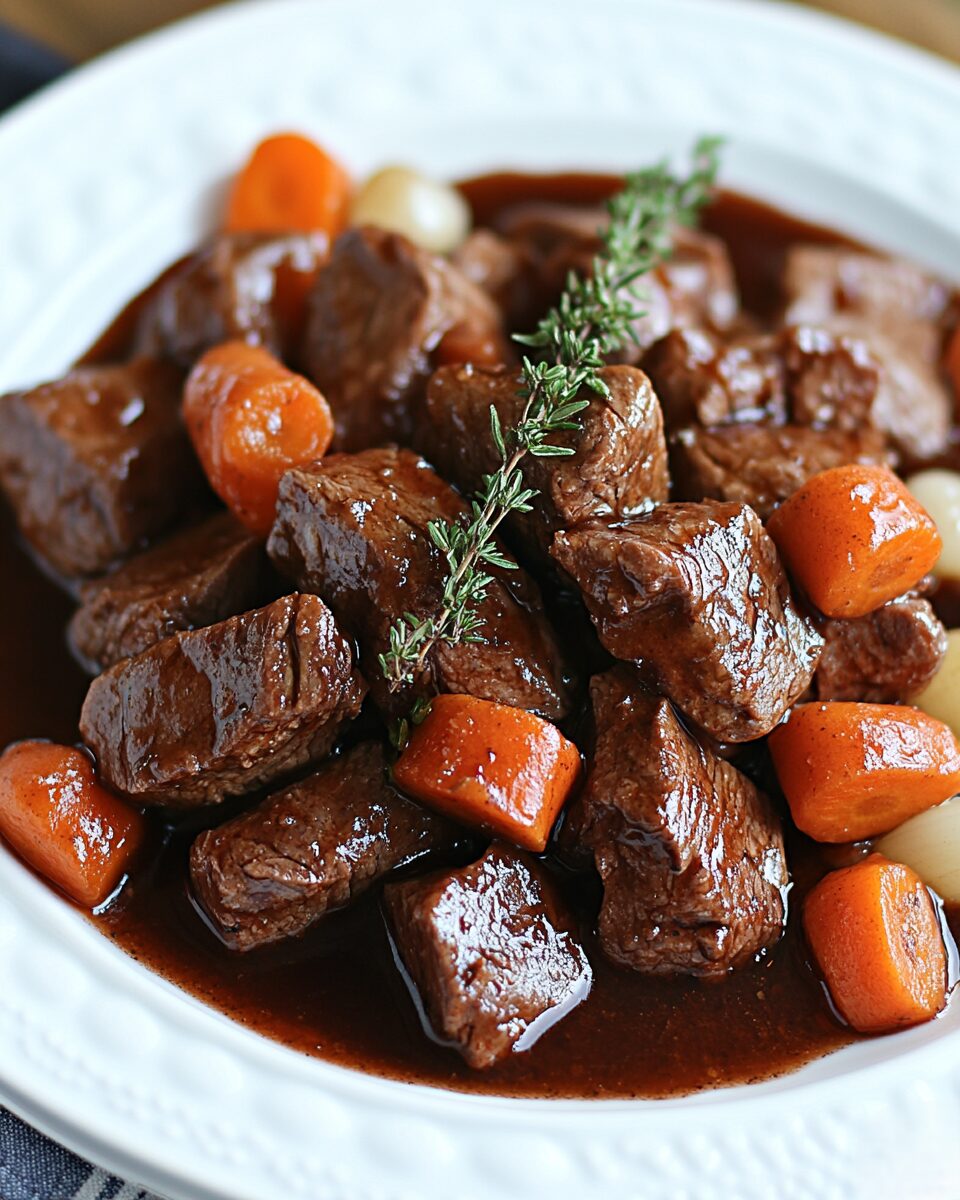Provençal Beef Stew, also known as Beef Daube, is a classic French dish from the Provence region. This flavorful stew is made by slowly braising beef in red wine, beef broth, and aromatic Provençal herbs like rosemary, thyme, and bay leaves. With the addition of vegetables like carrots, mushrooms, and pearl onions, this dish becomes a comforting and rich meal, perfect for family dinners or elegant gatherings. Traditionally cooked in a daubière (a ceramic pot for slow cooking), Beef Daube is a staple of French cuisine that enhances the tenderness of tougher cuts of meat through slow cooking.
Full Recipe:
Ingredients
- Beef: 3 lbs (1.4kg) sirloin tip roast or chuck roast
- Olive Oil: 2 tbsp
- Salt: 1 tsp
- Black Pepper: ½ tsp
- Onion: 1, diced
- Garlic Cloves: 4, minced
- Celery Stalks: 2, diced
- Tomato Paste: 2 tbsp
- Red Wine: 2 cups (500ml), preferably Côtes du Rhône or Syrah
- Beef Broth: 2 cups (500ml)
- Rosemary: 2 sprigs
- Thyme: 2 sprigs
- Bay Leaves: 2
- Baby Carrots: 1 cup (150g)
- Mushrooms: 1 cup (150g), halved
- Pearl Onions: ½ cup (optional)
Directions
Step 1: Prepare the Beef
- Trim excess fat from the beef and cut it into 2-inch (5 cm) cubes.
- Pat the beef dry with paper towels.
- Season with salt and black pepper.
Step 2: Sear the Beef
- Heat olive oil in a Dutch oven over medium-high heat.
- Sear the beef in batches until browned on all sides (about 2–3 minutes per side).
- Remove and set aside.
Step 3: Sauté the Vegetables
- In the same pot, add the diced onion, minced garlic, and diced celery.
- Sauté for about 5 minutes until softened.
- Stir in the tomato paste and cook for 1 minute to enhance flavor.
Step 4: Deglaze and Build the Stew
- Pour in red wine, scraping up the browned bits from the pot.
- Add the beef broth, rosemary, thyme, and bay leaves.
Step 5: Braise the Beef
- Return the seared beef to the pot.
- Stir in baby carrots, mushrooms, and pearl onions.
- Cover and bake in a preheated oven at 325°F (165°C) for 2 ½–3 hours, or until the beef is tender.
Step 6: Finish and Serve
- Taste and adjust seasoning with additional salt and pepper if needed.
- Garnish with chopped fresh parsley.
- Serve hot with crusty bread, mashed potatoes, or creamy polenta.
Nutrients (Per Serving, Approximate)
- Calories: 430 kcal
- Fat: 20g
- Carbohydrates: 10g
- Protein: 40g
Enjoy this rich and hearty French stew, perfect for warming up on a cold day! 🍷🍲
The History and Cultural Significance of Beef Daube
Beef Daube dates back to the medieval period when slow cooking was essential for tenderizing tougher cuts of meat. The name “Daube” is derived from the traditional ceramic pot, known as a daubière, in which the dish was originally cooked. In Provence, this stew became a staple due to the abundance of high-quality beef, robust local wines, and fragrant herbs. It was often enjoyed by farmers and laborers who needed a hearty meal that could be left to simmer for hours while they worked.
Throughout history, different regions in France have developed variations of Beef Daube, incorporating local ingredients and techniques. Some versions include olives, orange zest, or even anchovies, reflecting the Mediterranean influence on Provençal cuisine. Today, this dish remains a favorite in French households, celebrated for its deep flavors and satisfying texture.
What Makes Provençal Beef Stew Unique?
Unlike other beef stews, such as the famous Boeuf Bourguignon from Burgundy, Beef Daube emphasizes the use of Provençal herbs and often includes a lighter, more fragrant wine. The combination of rosemary, thyme, and bay leaves imparts a distinctive aroma, while ingredients like garlic and tomato paste add depth to the sauce. Additionally, the slow braising process enhances the meat’s tenderness, allowing it to absorb the flavors of the broth and wine fully.
One of the standout characteristics of Beef Daube is its flexibility. Traditionally cooked in a daubière, it can now be prepared in a Dutch oven, slow cooker, or even an Instant Pot for modern convenience. While the classic version features carrots, mushrooms, and pearl onions, some variations incorporate additional vegetables like potatoes or leeks.
Selecting the Best Ingredients for Beef Daube
A great Provençal Beef Stew starts with high-quality ingredients. Here are some essential components that elevate the dish:
- Beef Cuts: Tougher cuts like chuck roast or sirloin tip roast work best, as they become incredibly tender during slow cooking.
- Wine Selection: A full-bodied red wine, such as Côtes du Rhône or Syrah, enhances the depth of the stew.
- Aromatic Herbs: Rosemary, thyme, and bay leaves are essential for that signature Provençal flavor.
- Vegetables: Carrots, mushrooms, and pearl onions add texture and sweetness to the dish.
- Garlic and Tomato Paste: These ingredients enhance the umami and balance the richness of the stew.
Cooking Methods and Techniques
While the traditional daubière is an excellent choice for cooking Beef Daube, modern kitchens offer several alternatives. Here are some of the best methods for preparing this dish:
- Dutch Oven Method: Ideal for achieving a deep, rich flavor. Searing the beef first enhances the taste, and slow braising at a low temperature allows all the flavors to meld.
- Slow Cooker Method: Perfect for those who prefer a hands-off approach. Cooking on low for 6-8 hours ensures tender, fall-apart beef.
- Instant Pot Method: A faster option for busy cooks. Pressure cooking for about 45 minutes mimics the effects of long braising while reducing cooking time significantly.
Regardless of the method you choose, the key to a successful Beef Daube is patience. The longer the stew simmers, the more flavorful and tender the beef will become.
Serving Suggestions and Pairings
Provençal Beef Stew is incredibly versatile when it comes to serving options. Here are some classic pairings:
- Crusty Bread: A fresh baguette or rustic country bread is perfect for soaking up the rich sauce.
- Mashed Potatoes: Creamy mashed potatoes complement the tender beef and flavorful broth.
- Polenta: A classic choice in southern France, polenta provides a soft, comforting base for the stew.
- Rice or Pasta: Some prefer serving Beef Daube over rice or wide egg noodles for a heartier meal.
For wine pairings, consider serving the stew with the same type of red wine used in cooking, such as a Côtes du Rhône or Syrah. These wines have bold flavors that complement the richness of the dish.
Tips for Making the Perfect Provençal Beef Stew
To ensure your Beef Daube turns out perfect every time, follow these expert tips:
- Sear the Meat Well: Browning the beef before braising creates a rich, caramelized flavor.
- Use Quality Wine: A good-quality red wine enhances the taste and depth of the stew.
- Cook Low and Slow: The longer the stew simmers, the more flavorful it becomes.
- Let It Rest: Allowing the stew to sit for a few hours (or even overnight) intensifies the flavors.
- Adjust Seasoning at the End: Taste and adjust salt and pepper before serving to ensure a balanced flavor profile.
Why You Should Try Making Beef Daube
If you love comfort food that is rich in history and flavor, Beef Daube is a must-try recipe. Not only is it an iconic dish of French cuisine, but it also offers an excellent way to explore slow cooking techniques. This stew is perfect for meal prepping, as it tastes even better the next day when the flavors have had time to meld.
Additionally, Provençal Beef Stew is a wonderful way to introduce the aromas and flavors of Provence into your kitchen. Whether you’re an experienced home cook or trying your hand at French cuisine for the first time, this recipe is approachable and rewarding.
Conclusion
Provençal Beef Stew, or Beef Daube, is a timeless French dish that continues to delight food lovers worldwide. Its combination of tender beef, aromatic herbs, and deep flavors makes it a standout meal for any occasion. Whether served with crusty bread, mashed potatoes, or polenta, this stew is sure to become a favorite in your home.
By following traditional techniques and using high-quality ingredients, you can create an authentic and delicious Beef Daube that transports you to the sun-drenched countryside of Provence. So, pour yourself a glass of red wine, let the stew simmer slowly, and enjoy the magic of French cooking!






